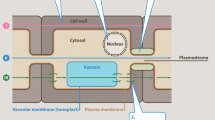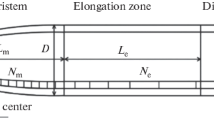Abstract
Aims
Elevated levels of metals reduce plant growth, including contaminated, acid, and saline soils, but much remains unknown regarding their mechanisms of toxicity. In this regard, it is important to understand the kinetics of changes in root elongation rate (RER) and root morphology.
Methods
Seedlings of soybean (Glycine max) were grown in solutions containing toxic levels of one of seven metals that differed markedly in their properties (Ag, Al, Ca, Cu, Hg, Na, and Sr), with mannitol and ‘mixed salts’ treatments also included.
Results
Despite their widely differing properties, all treatments caused similar symptoms, with roots swelling radially within the elongation zone, possibly associated with ethylene or auxin. In addition, Ag, Al, Cu, and Hg caused a rupturing of the outer root tissues likely associated with inhibition of wall loosening. Finally, using kinematic analyses to examine the effects of Hg in 5 min intervals, it was found that RER decreased by 50% after only 40 min, primarily associated with a decrease in the rate at which individual cells were elongating.
Conclusions
The information provided here will assist in understanding the mechanisms by which toxic levels of metals reduce root elongation.







Similar content being viewed by others
Abbreviations
- LEZ:
-
Length of the elongation zone
- MEER:
-
Maximum elemental elongation rate
- RER:
-
Root elongation rate
References
Alarcon MV, Lloret PG, Salguero J (2013) Auxin-ethylene interaction in transversal and longitudinal growth in maize primary root. Botany 91:680–685
Barceló J, Poschenrieder C (2002) Fast root growth responses, root exudates, and internal detoxification as clues to the mechanisms of aluminium toxicity and resistance: a review. Environ Exp Bot 48:75–92
Baskin TI (2013) Patterns of root growth acclimation: constant processes, changing boundaries. Wiley Interdiscip Rev Dev Biol 2:65–73
Basu P, Pal A, Lynch JP, Brown KM (2007) A novel image-analysis technique for kinematic study of growth and curvature. Plant Physiol 145:305–316
Blamey FPC, Nishizawa NK, Yoshimura E (2004) Timing, magnitude, and location of initial soluble aluminium injuries to mungbean roots. Soil Sci Plant Nutr 50:67–76
Blamey FPC, Kopittke PM, Wehr JB, Kinraide TB, Menzies NW (2010) Rhizotoxic effects of silver in cowpea seedlings. Environ Toxicol Chem 29:2072–2078
Blancaflor EB, Jones DL, Gilroy S (1998) Alterations in the cytoskeleton accompany aluminum-induced growth inhibition and morphological changes in primary roots of maize. Plant Physiol 118:159–172
Burssens S, Himanen K, van de Cotte B, Beeckman T, Van Montagu M, Inzé D, Verbruggen N (2000) Expression of cell cycle regulatory genes and morphological alterations in response to salt stress in Arabidopsis thaliana. Planta 211:632–640
Cramer GR, Epstein E, Läuchli A (1988) Kinetics of root elongation of maize in response to short-term exposure to NaCl and elevated calcium concentration. J Exp Bot 39:1513–1522
Eswaran H, Reich P, Beinroth F (1997) Global distribution of soils with acidity. In: Plant-soil interactions at low pH. Ed. A C Moniz. Brazilian Soil Science Society, Sao Paulo, pp 159–164
Ghassemi F, Jakeman A J, Nix H A (1995) Salinisation of land and water resources: human causes, extent, management and case studies. Canberra, Australia: the Australian National University, Wallingford, Oxon, UK: CAB international. CAB International, Wallingford pp. 544
Jones DL, Kochian LV (1995) Aluminum inhibition of the inositol 1,4,5-trisphosphate signal transduction pathway in wheat roots: a role in aluminum toxicity? Plant Cell 7:1913–1922
Jones DL, Blancaflor EB, Kochian LV, Gilroy S (2006) Spatial coordination of aluminium uptake, production of reactive oxygen species, callose production and wall rigidification in maize roots. Plant Cell Environ 29:1309–1318
Kinraide TB (1988) Proton extrusion by wheat roots exhibiting severe aluminum toxicity symptoms. Plant Physiol 88:418–423
Kinraide TB (2009) Improved scales for metal ion softness and toxicity. Environ Toxicol Chem 28:525–533
Kinraide TB, Yermiyahu U (2007) A scale of metal ion binding strengths correlating with ionic charge, Pauling electronegativity, toxicity, and other physiological effects. J Inorg Biochem 101:1201–1213
Kopittke PM, Blamey FPC, Menzies NW (2008) Toxicities of soluble Al, Cu, and La include ruptures to rhizodermal and root cortical cells of cowpea. Plant Soil 303:217–227
Kopittke PM, McKenna BA, Blamey FPC, Wehr JB, Menzies NW (2009) Metal-induced cell rupture in elongating roots is associated with metal ion binding strengths. Plant Soil 322:303–315
Kopittke PM, Blamey FPC, Kinraide TB, Wang P, Reichman SM, Menzies NW (2011) Separating multiple, short-term deleterious effects of saline solutions to the growth of cowpea seedlings. New Phytol 189:1110–1121
Kopittke PM, Menzies NW, Wang P, McKenna BA, Wehr JB, Lombi E, Kinraide TB, Blamey FPC (2014) The rhizotoxicity of metal cations is related to their strength of binding to hard ligands. Environ Toxicol Chem 33:268–277
Kopittke PM, Moore KL, Lombi E, Gianoncelli A, Ferguson BJ, Blamey FPC, Menzies NW, Nicholson TM, McKenna BA, Wang P, Gresshoff PM, Kourousias G, Webb RI, Green K, Tollenaere A (2015) Identification of the primary lesion of toxic aluminum (Al) in plant roots. Plant Physiol 167:1402–1411
Liu Q, Yang JL, He LS, Li YY, Zheng SJ (2008) Effect of aluminum on cell wall, plasma membrane, antioxidants and root elongation in triticale. Biol Plantarum 52:87–92
Llugany M, Poschenrieder C, Barceló J (1995) Monitoring of aluminium-induced inhibition of root elongation in four maize cultivars differing in tolerance to aluminium and proton toxicity. Physiol Plant 93:265–271
Massot N, Nicander B, Barcelo J, Poschenrieder C, Tillberg E (2002) A rapid increase in cytokinin levels and enhanced ethylene evolution precede Al3+-induced inhibition of root growth in bean seedlings (Phaseolus vulgaris L.) Plant Growth Regul 37:105–112
Matsumoto H (2000) Cell biology of aluminum toxicity and tolerance in higher plants. Int Rev Cytol 200:1–46
Matsumoto H, Motoda H (2012) Aluminum toxicity recovery processes in root apices. Possible association with oxidative stress. Plant Sci 185–186:1–8
Munns R, Termaat A (1986) Whole-plant responses to salinity. Aust J Plant Physiol 13:143–160
NLWRA (2002) Australians and natural resource management, http://www.nlwra.gov.au/. National Land and Water Resources Audit, Canberra
Osawa H, Endo I, Hara Y, Matsushima Y, Tange T (2011) Transient proliferation of proanthocyanidin-accumulating cells on the epidermal apex contributes to highly aluminum-resistant root elongation in camphor tree. Plant Physiol 155:433–446
Parida AK, Das AB (2005) Salt tolerance and salinity effects on plants: a review. Ecotoxicol Environ Saf 60:324–349
Parker DR (1995) Root growth analysis: an underutilised approach to understanding aluminium rhizotoxicity. Plant Soil 171:151–157
Pierik R, Verkerke W, Voesenek RACJ, Blom KWPM, Visser EJW (1999) Thick root syndrome in cucumber (Cucumis sativus L.): a description of the phenomenon and an investigation of the role of ethylene. Ann Bot 84:755–762
Sasaki M, Yamamoto Y, Matsumoto H (1996) Lignin deposition induced by aluminum in wheat (Triticum aestivum) roots. Physiolgia Plantar 96:193–198
Sasaki M, Yamamoto Y, Ma JF, Matsumoto H (1997) Early events induced by aluminum stress in elongating cells of wheat root. Soil Sci Plant Nutr 43:1009–1014
Sheldon AR, Menzies NW (2005) The effect of copper toxicity on the growth and root morphology of Rhodes grass (Chloris gayana Knuth.) in resin buffered solution culture. Plant Soil 278:341–349
Valentovičová K, Mistrík I, Zelinová V, Tamás L (2012) How cobalt facilitates cadmium- and ethylene precursor-induced growth inhibition and radial cell expansion in barley root tips. Cent Eur J Biol 7:551–558
Veitch FP (1904) Comparison of methods for the estimation of soil acidity. J Am Chem Soc 26:637–662
Winship LJ, Obermeyer G, Geitmann A, Hepler PK (2010) Under pressure, cell walls set the pace. Trends Plant Sci 15:363–369
Yamamoto Y, Kobayashi Y, Matsumoto H (2001) Lipid peroxidation is an early symptom triggered by aluminum, but not the primary cause of elongation inhibition in pea roots. Plant Physiol 125:199–208
Zelinova V, Haluskova L, Huttova J, Illes P, Mistrik I, Valentovicova K, Tamas L (2011) Short-term aluminium-induced changes in barley root tips. Protoplasma 248:523–530
Acknowledgements
Dr. Kopittke is the recipient of an Australian Research Council (ARC) Future Fellowship (FT120100277).
Author information
Authors and Affiliations
Corresponding author
Additional information
Responsible Editor: Juan Barcelo.
Electronic supplementary material
ESM 1
(PDF 179 kb)
Supplementary Video S1
A time-lapse video compiled from the kinematic analysis (Experiment 3) showing the growth of soybean roots in a solution containing 1 μM Hg, with a radial swelling forming. The video represents the period from 447 to 745 min after initially exposing the root to Hg. (AVI 10987 kb)
Supplementary Video S2
A time-lapse video compiled showing the growth of soybean roots in a solution containing 1 μM NPA, with a radial swelling forming. The video represents the period from 564 to 764 min after initially exposing the root to NPA. (AVI 8393 kb)
Rights and permissions
About this article
Cite this article
Kopittke, P.M., Wang, P. Kinetics of metal toxicity in plant roots and its effects on root morphology. Plant Soil 419, 269–279 (2017). https://doi.org/10.1007/s11104-017-3342-6
Received:
Accepted:
Published:
Issue Date:
DOI: https://doi.org/10.1007/s11104-017-3342-6




